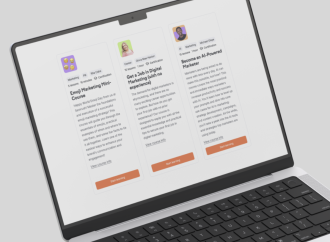Starting a business can be overwhelming. You’ve got product development, finding your audience, setting up your business, and trying to make it all profitable. The idea of creating a detailed marketing plan might feel like just another huge task, but it doesn’t have to be. In fact, a simple one-page marketing plan can be a

Starting a business can be overwhelming. You’ve got product development, finding your audience, setting up your business, and trying to make it all profitable. The idea of creating a detailed marketing plan might feel like just another huge task, but it doesn’t have to be. In fact, a simple one-page marketing plan can be a great way to stay focused on the essentials and guide your efforts without getting bogged down. It’s essentially a quick-reference blueprint that keeps you on track.
Let’s walk through how you can create a straightforward, one-page document that covers the key elements of marketing. By the end, you’ll have a clear and easy-to-follow plan to attract the right customers, keep your messaging consistent, and boost your sales. No need for a massive 50-page document—just the essential points that matter for your new venture.
Why a One-Page Marketing Plan?
Many new entrepreneurs get nervous about the idea of a marketing plan. Traditional plans can be long, packed with data and predictions, and feel like homework rather than a practical guide. A one-page marketing plan is different. It’s concise, to the point, and easy to update as you go along. It focuses on the who, what, and how of your marketing efforts, leaving out all the unnecessary details.
This approach saves time, which is valuable when you’re balancing so many tasks. Plus, it’s easy to share with team members or collaborators, and it’s flexible enough to revise as you learn more. The goal is to have something that’s useful and keeps you moving forward.
Start With Your Target Audience
First things first, who are you trying to reach? Think about your ideal customer. Are they eco-conscious young professionals? Or perhaps busy parents in need of time-saving solutions? The more specific you can be about your target audience, the better. Instead of saying “everyone,” narrow it down. Consider things like age, location, income, interests, and pain points.
For example, you could create a customer profile like this:
- Name: “Busy Brenda”
- Age: Mid-30s
- Lifestyle: Full-time job, family, little time for shopping or cooking
- Pain Point: Needs convenient, healthy meals that are affordable
This helps you visualize who you’re speaking to, so you can tailor your messaging and promotions to meet their specific needs.
Clarify Your Value Proposition
What makes you stand out from your competitors? Maybe your product is more affordable, better designed, or more eco-friendly. Your value proposition should clearly explain why customers should choose you.
For example: “We offer fresh, ready-to-cook meal kits for busy families, delivered straight to your door at an affordable price.” This statement tells customers exactly what you offer and how it solves their problem.
Keep it short—just one or two sentences. This will guide your marketing message and should answer the customer’s key question: “Why should I buy from you?”
Define Your Core Marketing Message
Now, how will you talk to your audience? Your value proposition shows what makes you special, but your core marketing message is how you’ll communicate that uniqueness. It’s the tone, style, and promise you make to your customers. You might focus on convenience (“Save time every day”), health (“Feel great with nutritious meals”), or affordability (“Save on groceries without compromising on quality”).
Make sure your message connects with what your audience cares about. For example, if you’re targeting Brenda, you might say, “Healthy, easy-to-prepare meal kits to help you reclaim your evenings.”
Choose the Right Marketing Channels
Where will you reach your audience? Once you know who you’re talking to and what your message is, it’s time to figure out where to share it. The best channels will depend on where your target audience hangs out. For example, LinkedIn might be great for professionals, while Instagram or TikTok could work better for younger consumers. For local businesses, consider using community events or local Facebook groups.
Some common channels include:
- Social Media (Instagram, Facebook, TikTok, LinkedIn)
- Email Marketing (Newsletters, promotions)
- Content Marketing (Blog posts, YouTube videos)
- Local Advertising (Flyers, posters, local media)
- Partnerships (Collaborating with local businesses or influencers)
You don’t need to use all of them—start with one or two channels that fit your business and audience, and focus on consistency.
Set Specific Marketing Goals
What do you want to achieve with your marketing? Goals are essential for measuring success. For instance, you might want to grow your email list by 500 subscribers over the next three months or sell 200 units in your first month. Setting clear, measurable goals keeps you focused and helps you determine what’s working.
Examples of marketing goals might include:
- Increase website traffic by 30% within six weeks
- Gain 1,000 social media followers by the end of the quarter
- Achieve a 10% conversion rate on a new landing page
Make your goals specific and realistic, but also a little ambitious. Without clear goals, it’s hard to measure your success. With them, every marketing decision becomes more purposeful.
Outline Key Strategies and Tactics
Now, how will you achieve those goals? This is where you lay out the main strategies you’ll use. For example, if one of your goals is to grow your email list, one strategy could be to offer a free downloadable guide in exchange for sign-ups. Another strategy might be running targeted social media ads.
Keep your strategies simple, and align them with your goals and marketing channels. Here’s an example:
- Strategy: Offer a free mini-recipe eBook to drive newsletter sign-ups
- Tactic: Promote the freebie through Instagram Stories, linking to the sign-up page
Think of your strategies and tactics as the steps to take to reach your goals. It’s like following a recipe—each step brings you closer to your finished product.
Establish Your Budget and Timeline
How much can you spend, and when? It’s essential to know your budget, even if you’re just starting out with limited funds. Allocate a rough dollar amount to each marketing channel or tactic. Maybe you’ll spend $200 on social media ads this month, $50 on email marketing software, and $100 for a booth at a local event.
You’ll also need a timeline. If you’re launching a product in April, for example, you’ll want to start promoting a month or two ahead. Perhaps run ads two weeks before launch, send a press release a few days before, and host a live Q&A on launch day.
Decide on Metrics and How You’ll Track Progress
How will you know if your marketing is working? Metrics help you track success. Some key things to monitor include:
- Website traffic (via Google Analytics)
- Email open and click-through rates
- Social media engagement (likes, shares, comments)
- Conversion rate (how many visitors become paying customers)
- Sales numbers (units sold after a promotion)
Pick a few metrics that align with your goals, and monitor them regularly. This helps you spot what’s working and adjust as needed.
Keep It Short, Simple, and Visible
The whole point of a one-page marketing plan is to keep it clear and concise. Aim to fit everything onto a single sheet or screen. Use bullet points and simple charts to make it easy to read and update. Once it’s done, keep it visible—print it out and hang it by your desk or store it digitally so you can refer to it often.
Be Ready to Adjust as You Learn
Your plan isn’t set in stone. Once you launch your campaigns, you might discover that one platform is performing better than another, or that your audience responds more to a particular message. Don’t be afraid to adjust your plan based on what you learn.
A one-page marketing plan is flexible. Update it regularly as your business grows and as you gather insights. This flexibility is one of the biggest advantages for new entrepreneurs who need to adapt quickly.
Add a Brief Competitive Snapshot
It can be helpful to quickly note a couple of your main competitors and what they do well. Just a sentence or two about how your business stands apart can remind you to stay differentiated. For example, if a competitor focuses on high-end ingredients, highlight how your brand focuses on budget-friendly, healthy meals.
Leverage Free Tools and Resources
Marketing doesn’t have to be expensive. Plenty of free or low-cost tools can help you streamline your efforts. Tools like MailChimp or ConvertKit for email marketing, Canva for designing social media posts, or Hootsuite for scheduling can save you both time and money.
Bring It All Together
When you’ve completed your one-page plan, it might look like this:
- Target Audience: Busy families needing convenient meals
- Value Proposition: Affordable, nutritious meal kits delivered weekly
- Core Message: “Reclaim your evenings with quick, healthy dinners”
- Channels: Instagram, Local Events, Email Newsletter
- Goals: 500 email sign-ups in 3 months, 10% conversion rate on landing page
- Strategies/Tactics:
- Offer free recipe eBook for email sign-ups
- Run Instagram video ads showing easy meal prep
- Attend local family-oriented weekend markets
- Budget: $300/month on ads, $50/month email service, $75/event booth fee
- Metrics: Email sign-ups, Instagram engagement, conversion rate, monthly sales
- Competition: Competitor X focuses on gourmet—our angle: budget-friendly healthy meals
This gives you a snapshot of your entire marketing plan, so you can stay focused and organized.
Moving Forward With Confidence
A one-page marketing plan is simple but effective. Instead of getting bogged down in complex theories, you’ll focus on the essentials: who you’re serving, what you’re offering, and how you’ll tell your story. As you grow, your plan can evolve, allowing you to adapt and adjust as needed. With a clear, flexible plan, you’re ready to confidently take your business to the next level.

















Leave a Comment
Your email address will not be published. Required fields are marked with *